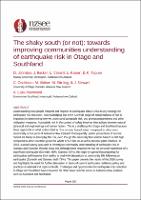The shaky south (or not): towards improving communities understanding of earthquake risk in Otago and Southland

Download
Date
2022-04-27Authors
Johnston, David
Orchiston, Caroline
Becker, Julia
Vinnell, Lauren
Kaiser, Lucy
Stewart, Joshua
Lake-Hammond, Alice
Stirling, Mark
Tapuke, Kelvin
Akther, Marufa
Metadata
Show full item recordAbstract
Understanding how people interpret and respond to earthquake risks is vital to any strategy for earthquake risk reduction. Acknowledging that there is a wide range of interpretations of risk is important in determining how we understand acceptable risk, and prompt preparedness and other mitigation measures. Acceptable risk in the context of safety involves interactions between natural (physical and engineering) and human factors. This is a challenge for Otago and Southland because these regions lie in what is described as ‘low seismic hazard zones’ compared to other more seismically active parts of Aotearoa New Zealand. Consequently, public perceptions of seismic hazard are likely to downplay the risk, even though this relatively low seismic hazard is still high compared to other countries given the whole of NZ lies on an active tectonic plate interface. In 2016, a postal survey was used to investigate community understanding of earthquake risk in Oamaru and Dunedin. Results show that although most respondents had no personal experience of a significant earthquake (Dunedin: 80%, Oamaru: 65%), the majority agreed that preparing for earthquakes will improve their ability to deal with disruptions to community life following an earthquake (Dunedin and Oamaru: both 78%). This paper presents the results of the 2016 survey and highlights the need for further discussion in terms of current earthquake policy and practices at national and regional levels. Challenges and opportunities for earthquake risk reduction in Otago and Southland have relevance for other lower seismic zones in Aotearoa New Zealand, such as Auckland and Northland.
